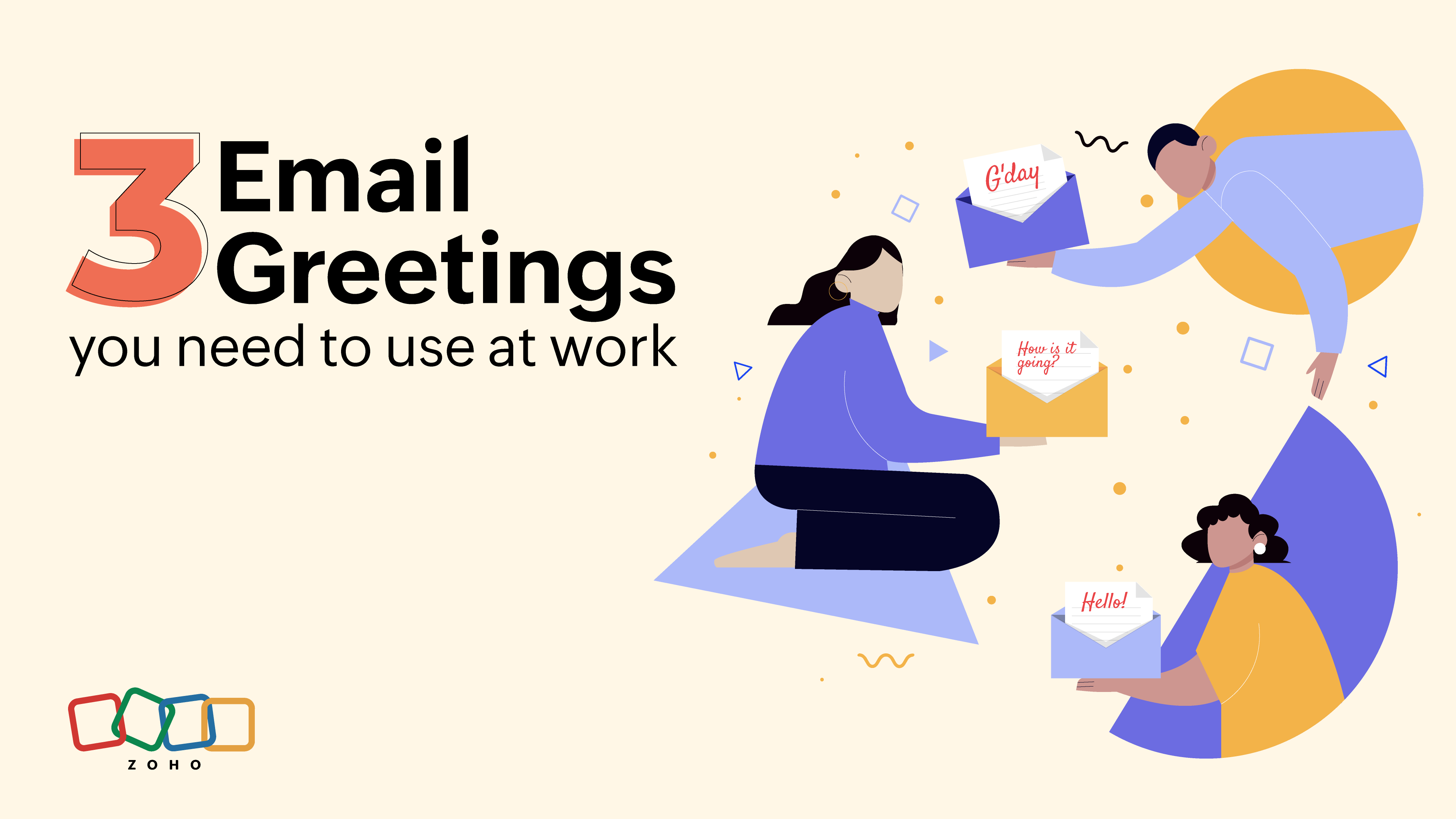- HOME
- All Products
- The 3 email greetings you need to use at work
The 3 email greetings you need to use at work
- Published : September 19, 2023
- Last Updated : July 24, 2024
- 1.4K Views
- 5 Min Read
The first line of the next email you send your boss, coworkers, or interdepartmental colleagues sets the tone for the rest of your message. Your opening words reveal a lot about your emotional state at the time you penned your email: They may set a tone that oozes confidence and promotes transparency among team members. Or, in the worst-case scenario, tone deficiencies in your email’s opening words can impact morale and sow confusion.
To that end, let's quickly cover some ways one should—and shouldn't—begin their work emails as well as some examples you can recreate. We'll also provide a few tips along the way to improve your email writing and set your designed tone.

Start using a better email account
First things first. Upgrade whatever email account you're using to one that increases your productivity and reduces inbox clutter. Choose a modern, high-quality email solution that includes email reminders and lets you snooze messages selectively so that you're only clearing out your inbox when marketing sends you their Friday newsletters. It’s okay—we won’t tell if you won’t.
Using a higher-quality email account also improves your future meetings and collaborative follow-ups because your new email tracking features let you know the delivery status of each email you send. If you notice a teammate continuously opening your messages without responding, it may also indicate that the email greetings you're using aren't striking the impact you want.
Email greeting examples you should be using
Just because there are certain email greetings we recommend using, that doesn't mean there are hard and fast rules that should always govern your writing. The considerations you make when penning your first line make for a surprisingly complex situation. You should consider the following:
Your relationship with your recipient(s). Are you close? How long have you known each other?
The specific context in which your email exists. Is it an opening email? When was the last time you responded? Is the matter urgent?
Your expectations for results after you click "send." Are you expecting a yes/no offer? Is your goal to get some more information? What feelings do you intend to induce in the recipient?
In general, there are specific types of email greetings for each situation. First and foremost, think about the context and then zero in one of the following email greeting examples:
Cold email greetings
Use these greetings for messages you send to people you don’t know too well. Cold email greetings are useful if you're reaching out to leads you found in your CRM or are disseminating marketing collateral that a wide audience may interact with. It's best to make your cold email greetings sound detached enough to avoid seeming too familiar and getting dropped into someone's junk folder.
A few greetings that will work if you're contacting unknown recipients may include a simple "Dear sir/madam" or "To whom it may concern." If you're reaching out to someone you’ve already met, a cold email greeting like "Dear Mr./Mrs." or "Dear <FIRST NAME>" works just fine.
A general rule of thumb when sending cold emails and refining your cold email greetings: Do your homework and make sure you've done enough research to establish personalized context. Emailing someone who wrote an article you read and loved? Praise their prose after you've hit them with a "Dear Mr./Mrs." and leverage personalization to encourage them to keep reading.
Informal email greetings
You've probably sent your fair share of informal email greetings just in the span of the last 24 hours. These are the greetings you send your boss, friends, and family members, although they may also be ones you send in conventionally formal contexts. The cold outreach messages we just talked about, for example, are increasingly commonplace in traditionally formal contexts, so use some discretion when writing emails with informal greetings.
There are dozens of potential options at your disposal, but some of the most common informal greetings include:
Dear <FIRST NAME>
"Hi"
"How's it going, <FIRST NAME>?"
"It's been a while!"
"I hope you're having a good week so far"
"I was hoping to get your thoughts on <SUBJECT MATTER>"
“Long time no see!”
And so on. Informal email greetings give you the opportunity to test out some email writing best practices like writing concise subject lines and stating the purpose of your message from the get-go. So long as you keep things positive and confident, though, you'll be well on your way toward improving your open rates and getting more replies back.
Follow-up email greetings
Last, but not least, are the follow-up greetings you'll send to people with whom you've already established contact. As the name suggests, follow-up greetings should prioritize getting to the point of your last contact quickly and mitigating any confusion in the process.
However, follow-up emails often necessitate a level of efficiency that goes beyond just composing the right message. Especially when you're dealing with a multitude of PDF files that require editing, finding, and sending back for feedback or revisions, you can quickly get lost and keep your contacts waiting for a follow-up.
In such scenarios, having an efficient document management system is not just an add-on; it's a necessity. While your conversation may span multiple topics such as project deadlines or budget constraints, a seamless way to handle comprehensive reports, revised proposals, or technical documents—akin to what you'd experience with an all-in-one collaboration solution—can significantly streamline the follow-up process, keeping the dialogue productive and on course.
In terms of specific examples, though, there are no strict rules you need to follow to craft a solid follow-up greeting. Simple greetings that quickly get to the point like "I'm checking in on..." or "Can you please provide an update on..." work well for emails that need to sound professional but don't demand a ton of your time.
Email greeting writing tips to follow
You should always iterate on your email writing process and build upon lessons learned to elicit positive responses from your recipients and clearly and consistently convey your communications. Being acquainted with email etiquette will also be helpful in crafting the perfect email.
A few final thoughts we have on writing great email greetings:
Reply to emails the same way you'd write them: use a straightforward greeting like "Thanks for the update" to encourage a timely response.
Consider the time of day and include a "Good morning/afternoon," "Good evening," or "G'day" if you find yourself in the Land Down Under.
Remember that you've got choices if you're emailing more than one person. If possible, include everyone's name in your greeting so that each person is more likely to open and read your message.
Don't be afraid of using humorous greetings or leveraging humor to break the ice. At the end of the day, everyone's a human behind the screen who may appreciate a little lightness of tone.
Conclusion
Now that you're familiar with some common email greetings for cold emails, informal emails, and follow-up emails, share your takeaways with your team and see how you can improve your email greetings on a department-wide scale.
Whether you're emailing your coworker who shares your cubicle or reaching out to a brand new lead, having an arsenal of carefully curated and well-thought-out email greetings helps you avoid miscommunication, establish clear intentions, and set a positive and confident tone at the outset of every email you send.
 Gary Stevens
Gary StevensGary Stevens is the CTO of Hosting Canada, a website that provides expert reviews on hosting services and helps readers build online businesses and blogs. Gary specializes in topics on cloud technology, thought leadership, and collaboration at work.


